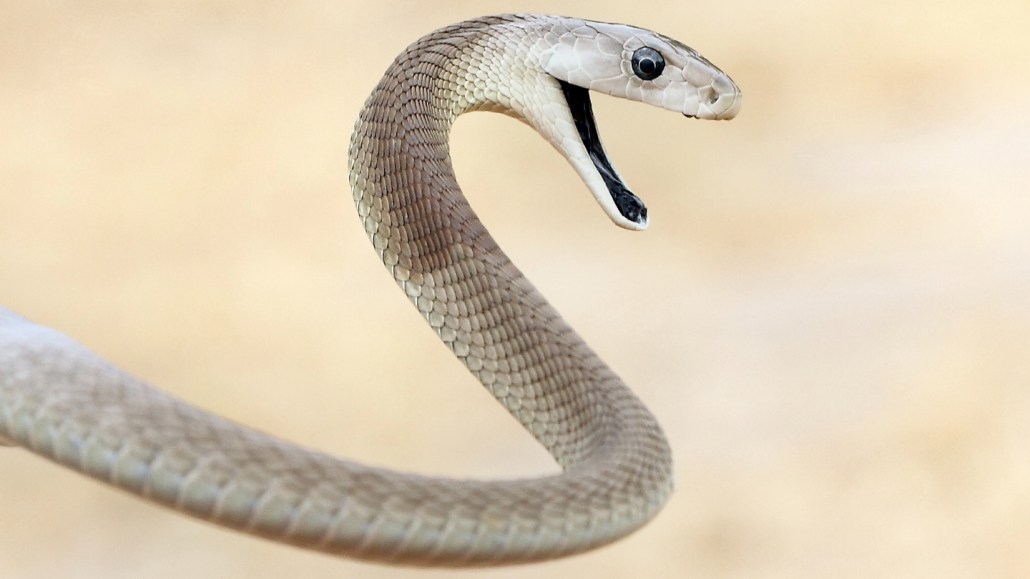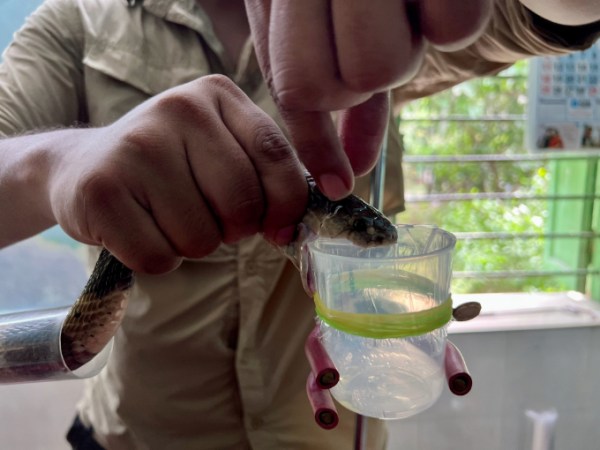Snake venom toxins can be neutralized by a new synthetic antibody
Lab-made antibodies could be the answer to deadly snakebites

Toxins in the venom of black mambas (one shown) and certain other snakes can paralyze snakebite victims. A lab-made antibody that targets these toxins could be a step toward a universal antivenom.
suebg1 photography/Moment/Getty Images Plus
The antivenom for a black mamba’s bite could one day work for a slew of other snakes.
Scientists have developed an antibody that shuts down paralyzing toxins in the venom of black mambas, king cobras and dozens of other sharp-toothed serpents. The antibody — a single protein manufactured in the lab — protected mice from otherwise lethal doses of venom, protein engineer Joseph Jardine and colleagues report in the Feb. 21 Science Translational Medicine. That antibody “will be a critical component of an eventual antivenom,” says Jardine, of the Scripps Research Institute in La Jolla, Calif.
Venomous snakes generally rely on just a handful of toxin families. If scientists could mix together antibodies targeting each of those types, Jardine says, they could potentially create “one vial of antivenom that works against any snake in the world.” Such a universal antivenom might still be many years away, he says. But “theoretically, this is possible.”
Scientists have tallied hundreds of venomous snake species across the globe. In North America, a person might stumble upon a western diamondback; in Africa, a puff adder; in South Asia, a saw-scaled viper. A bite from any one of these snakes can maim or kill. Venomous snakebites kill up to about 140,000 people each year, according to the World Health Organization. Lifesaving antivenoms exist, Jardine says, but they’re “built with 100-year-old technology.”
That technology involves injecting animals like horses or sheep with snake venom and harvesting the venom-targeting antibodies that their immune systems churn out. A snakebit patient would then get an infusion of horse or sheep antibodies — if doctors have them in stock.

The process has major drawbacks, Jardine says. Each animal produces antibodies for just one type of venom. Currently, bites from a yellow-bellied sea snake, cottonmouth or inland Taipan would all require different treatments. Another issue is the health effects of the antivenom itself. “You’re putting a whole bunch of horse antibodies into a person,” Jardine says. People can get sick or even go into anaphylactic shock.
His team’s approach could glide past those problems. In a collection of more than 60 billion lab-made antibodies, the team hunted for ones that target a particularly vicious venom component used by some snakes: long-chain three-finger alpha-neurotoxins.
These molecules look like a small hand with three fingers, says biotechnologist Andreas H. Laustsen-Kiel of the Technical University of Denmark in Kongens Lyngby. When delivered into a person’s bloodstream via snakebite, the hand literally gives victims the finger. The toxin’s middle finger pokes into a protein needed for movement, shutting down muscles and paralyzing the body.
Antibodies that grasp the finger can block its toxic touch, Laustsen-Kiel says. Last year, his group reported several new antibodies, including a human antibody that neutralizes three-finger toxins like the one in Jardine’s study. But the new antibody “looks like it’s even better than ours,” Laustsen-Kiel says. It appears to grab a wider array of toxins and with a tighter grip, he says.
In mice given venom from a black mamba and an Indian spitting cobra, injecting the antibody saved the rodents’ lives, Jardine’s team reports. The researchers are now working to develop antibodies that target other venom toxins.
Still, the idea of creating a single, universal antivenom may not be entirely realistic, Laustsen-Kiel says. “It simply doesn’t make sense from a product perspective,” he says. Instead, Laustsen-Kiel envisions antivenoms that are tailored for use in specific regions.
Whatever the formulation of these future antivenoms, research on snakebites — considered a neglected tropical disease — is underfunded, Jardine says (SN: 9/19/20). Though millions of cases occur in rural India and Africa, there’s relatively little money available for improving treatments, he says. (Jardine has funding from the London-based global health charity the Wellcome Trust.) Snakebites just aren’t considered a medical priority, Jardine says. But for people whose families and livelihoods depend on their ability to farm, he says, losing life or limb to snakebite is devastating.







